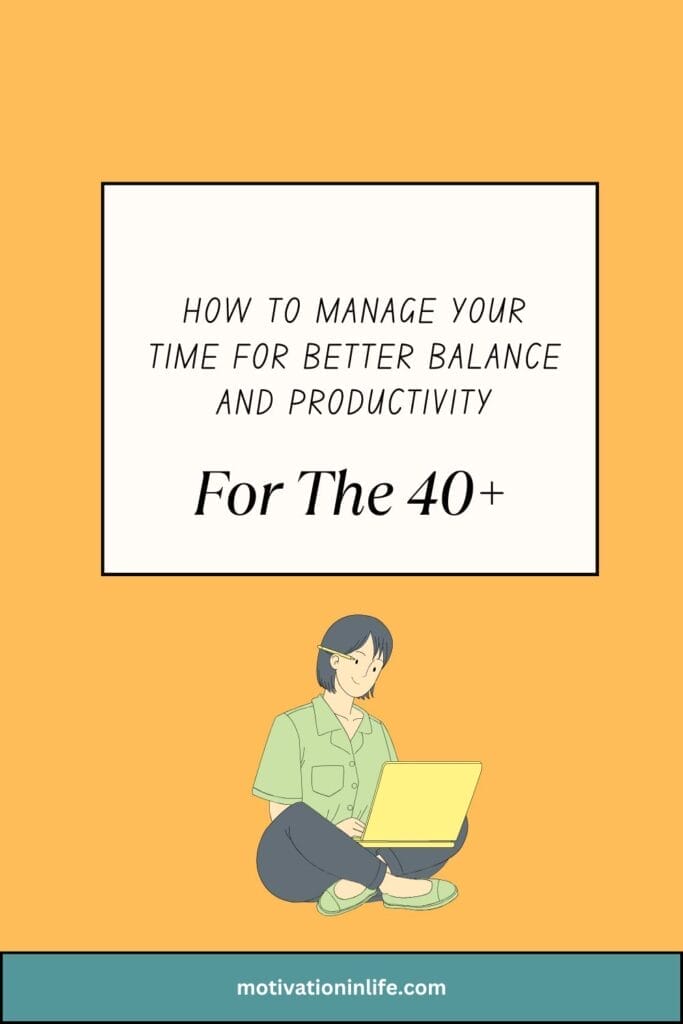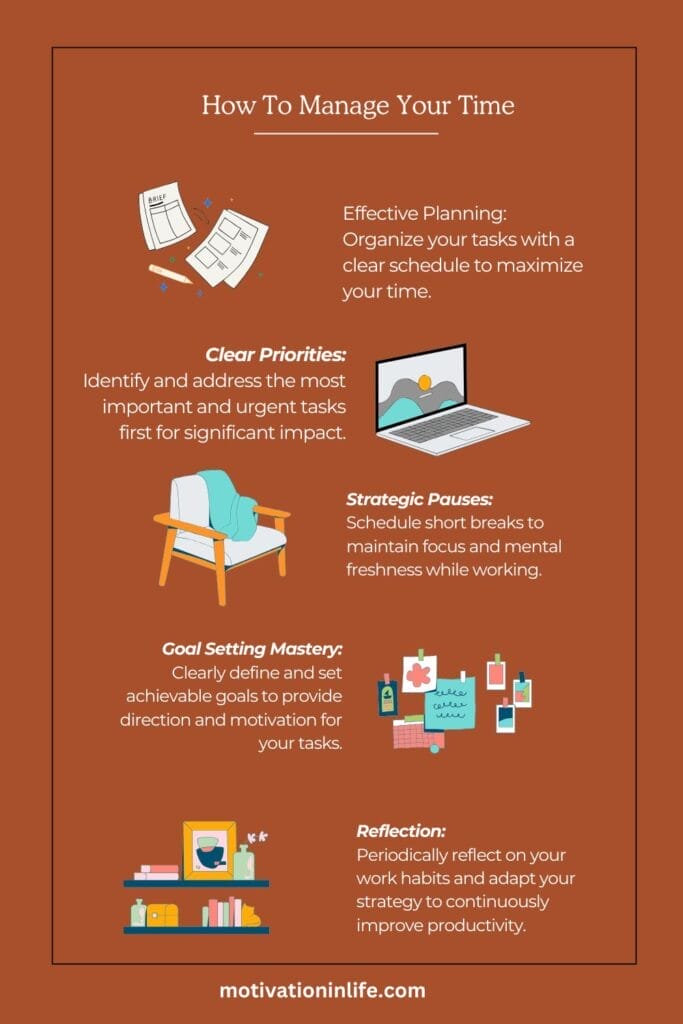How To Manage Your time For Better Balance and Productivity (For The 40+)
Learning how to manage your time effectively becomes even more essential once you hit 40. Finding the right balance can feel challenging with careers, family, and personal interests all competing for attention.
Knowing how to use time productively and efficiently can be the key to completing what matters most to you each day while keeping stress to a minimum.
If you’re looking to make better use of your time, these straightforward, adaptable tips on how to manage your time can help.
Table of Contents
AFFILIATE DISCLOSURE
This post may contain affiliate links. We may earn a small affiliate commission at no extra cost if you click on them.
motivationinlife.com is also a participant in the Amazon Services LLC Associates Program, an affiliate advertising program designed to provide a means for sites to earn advertising fees by advertising and linking to Amazon.com and Amazon.in
We may earn a small commission for our endorsement, recommendation, testimonial, and/or link to any products or services from this website.
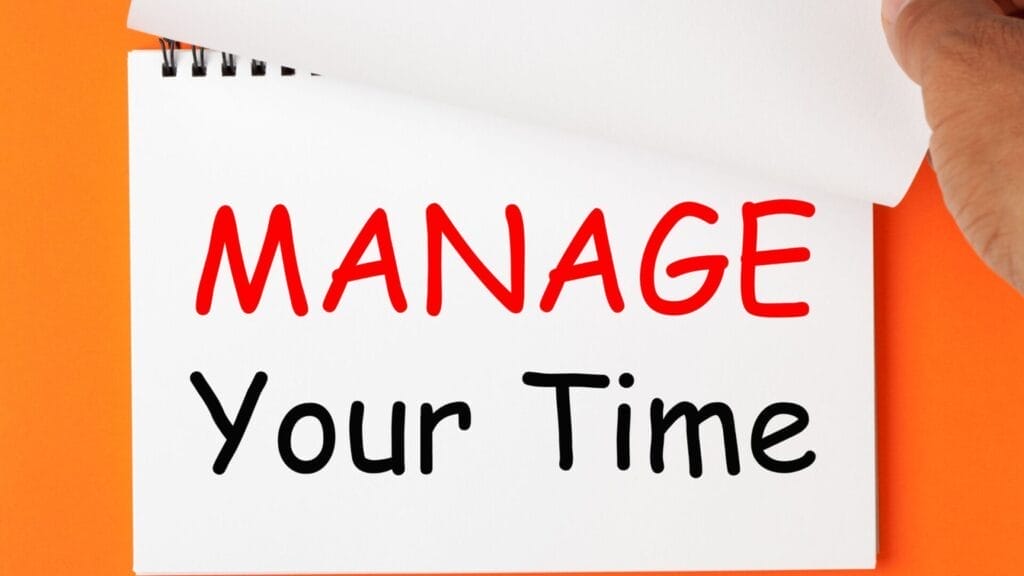
Why Is Time Management Important Especially In Midlife
Time management becomes especially valuable in midlife as responsibilities often multiply.
Balancing career and family commitments can be demanding at this stage so managing time well helps prevent burnout and maintain productivity.
Plus by managing your time properly you give yourself space for personal goals, like your health and hobbies, that are essential for long-term well-being.
At the same time, effective time management skills help reduce stress by creating a more organized approach to daily tasks, allowing for a more fulfilling and balanced life.
Planners are a great tool to help you manage your time effectively You can take the help of the Weekly Planner we have designed for you using the templates at Creative Fabrica.
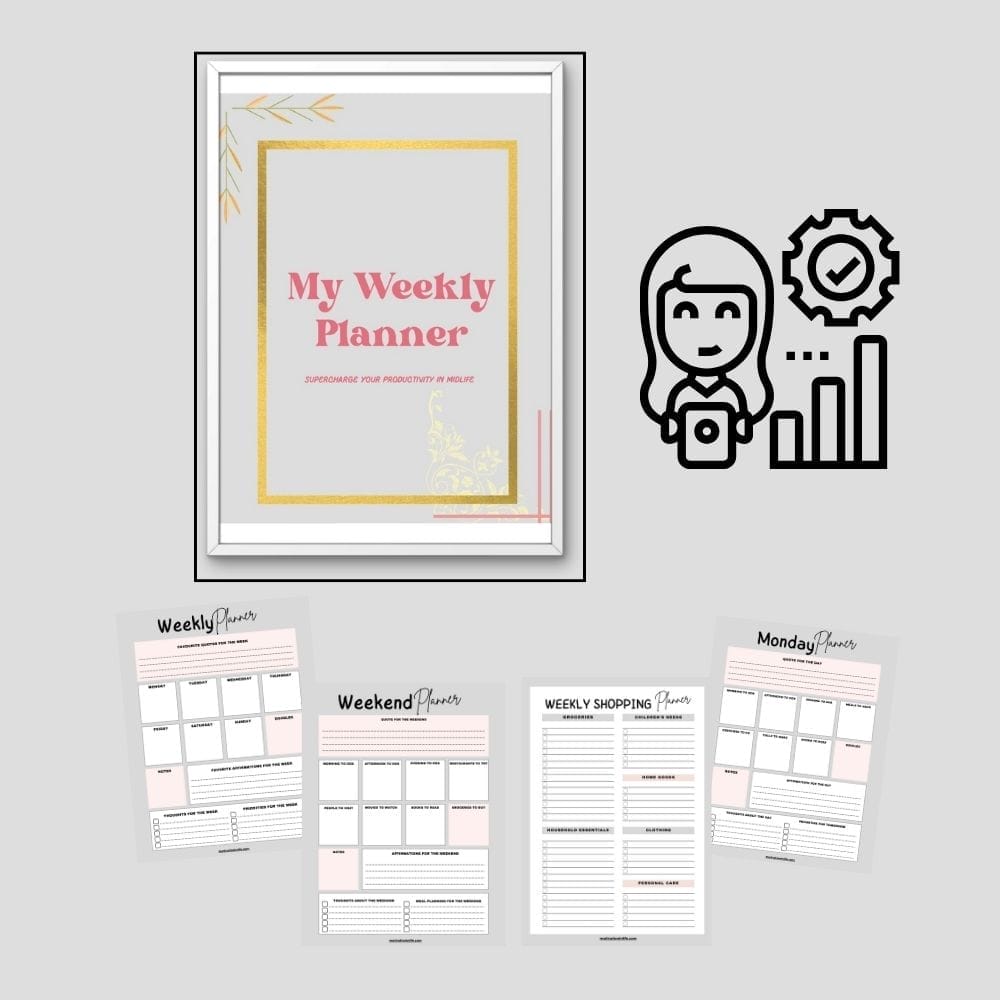
How To Manage Your Time-Time Management Tips That Work In Life After 40
Here are 12 tips and methods to manage time that will help you ascertain how to manage your time even if you are super busy in life!
Prioritize What Matters Most To Increase Your Productivity
Start by setting priorities that reflect what’s most important to you right now. Many of us have long to-do lists, but not every item needs immediate attention. Create a list and categorize tasks in order of importance.
For instance, home tasks can be sorted from those that truly need to get done at the top, to less urgent ones below. Do the same with work tasks. A well-organized list helps you focus your energy where it counts.
For someone in midlife balancing work, family, and personal commitments, prioritizing tasks can bring significant clarity and efficiency.
Here’s a practical example of how to use prioritization effectively.
Imagine you’re juggling work deadlines, family obligations, and home responsibilities. Start by creating a master list that includes tasks from all areas of your life for the week.
Divide the List into Categories
Split the list into three main sections: Home, Work, and Personal/Health.
Prioritize by Urgency and Importance
Within each category, rank tasks by priority:
High Priority – Tasks that need immediate action or have a deadline, like submitting a project at work, paying bills, or attending a child’s school event.
Medium Priority – Tasks that should be done soon but aren’t urgent, like grocery shopping, catching up on emails, or scheduling medical checkups.
Low Priority – Tasks that would be nice to complete but don’t have immediate consequences, such as organizing storage or browsing new recipes.
Create a Weekly Plan
For high-priority tasks, schedule specific times during the day or week when you’re typically most focused. For example, if you’re a morning person, tackle critical work projects first thing each day.
Assign medium-priority tasks to less intense periods, like midday, when energy might be lower. Perhaps you can fit a quick grocery trip on your lunch break or check emails.
Reserve low-priority tasks for the end of the week or weekend when you have extra time or can delegate them to others.
Be Flexible and Re-Evaluate Daily
Every evening, check your list and adjust as needed. If something urgent comes up at work, you might move a medium-priority household task to the weekend. By regularly reviewing, you’ll keep the focus on what’s most essential while leaving space for unexpected events.
This approach helps direct energy toward what truly matters each day while ensuring lower-priority tasks don’t clutter your mind or schedule. By practicing this consistently, time management becomes smoother and less overwhelming.
I recently attended the second brain challenge that was organized by my blogger friend Lindsay Kelly. In the challenge, she taught us how to create all your important links and tasks organized.
It is like having all that is there either in your mind or your tasks and links that are scattered all over in one place where you can access it all at once. Therefore the name second brain, where you store all your information to which you have immediate access.
If this sounds interesting the second brain challenge is still open. I have benefitted a lot by participating in this challenge. You should definitely give it a try if you really want to manage your time appropriately.

Recognize How Long Things Take To Manage Your Time Well
To manage time well, it’s helpful to understand how long regular activities actually take. Consider common tasks like cooking dinner, running errands, or catching up on emails.
Try timing yourself on these routines to get a sense of how much time you need. It will make it easier to create a schedule that works without overloading you.
Understanding how long everyday tasks take can be especially beneficial for someone in midlife when handling multiple responsibilities is common.
Here’s a practical way on how to manage time by incorporating this approach:
Choose Key Daily Tasks
Start by identifying the core tasks you complete most days or weeks. For someone in midlife, this may include preparing meals, commuting, exercising, family commitments, and routine work tasks like meetings or emails.
Time Each Task Over a Few Days
For a week, try noting the start and finish times of these activities to get an accurate sense of how long each typically takes. Use a simple timer or a phone app for convenience. For example:
Cooking Dinner: Track the time it takes from preparation to cleanup.
Commute Time: Track time from leaving home to arriving at work and back, especially if you have multiple stops.
Emails or Meetings: Note how long it takes to catch up on messages or the average length of routine meetings.
Set Realistic slots in Your Calendar
Once you know how much time each task requires, block it out in your calendar accordingly. For instance:
If cooking and cleanup generally take 45 minutes, block that time each evening so you don’t feel rushed.
If emails take 30 minutes every morning, set that time aside specifically to avoid interruptions.
Use These Insights to Plan Ahead
With a clearer idea of how much time tasks truly need, planning becomes easier and more realistic.
For example, if Saturday mornings are for errands and you know it typically takes two hours, you can avoid overbooking or underestimating time for other weekend activities.
Adjust as Needed
Repeat timing tasks periodically to stay realistic about how long they take. Life changes—work shifts, and family demands grow—so checking in every few months can help keep your time management balanced and effective.
This approach helps create a structured schedule that works in harmony with daily life, making it easier to balance obligations without feeling overwhelmed.
Setting up your daily routine goes a big way in helping you manage your time better, Please read our blog post Why Your Routine Matters For Changing Life Habits (For The 40+) to understand the importance of scheduling your life.

Try Time Blocking to Structure Your Day
For some, a simple to-do list isn’t enough. Time blocking can be a helpful way to divide your day into dedicated periods for specific activities.
For example, you might reserve 30 minutes each morning for exercising or an hour in the afternoon for errands or decluttering.
By creating blocks of time for tasks, you add structure to your day and are more likely to finish what you set out to do.
Time blocking can be a highly effective method for people in their 40s and beyond to stay organized and accomplish daily tasks without feeling overloaded. Here’s how it can be applied practically:
Identify Your Key Responsibilities and Priorities
Start by listing the regular tasks you need to complete in a day or week, dividing them by category—work, family, health, and personal goals. For example:
- Work-related tasks (emails, meetings, projects)
- Family tasks (meal prep, errands, kids’ activities)
- Health (exercise, medical appointments)
- Personal interests (reading, hobbies)
Set Aside Time Blocks Based on Energy Levels
Recognize when you tend to feel most energetic or focused throughout the day. For instance, if you feel sharpest in the morning, reserve that time for work tasks that require high concentration, like meetings or complex projects.
Save lower-energy times, such as after lunch, for routine tasks, like responding to emails or handling minor household chores.
Create Blocks of Time for Each Activity Category
Start with 30-60 minute blocks for each type of activity. For example:
- Morning: 30 minutes for exercising, 1 hour for focused work on priority projects.
- Late Morning/Early Afternoon: 1-2 hours for meetings or collaborative work.
- Afternoon: 1 hour for errands or emails, followed by 30 minutes to check messages.
- Evening: Family time, followed by 30 minutes for personal interests or relaxation.
Adjust and Customize Blocks to Fit Your Schedule
Every day can vary, so keep flexibility in mind. If something unexpected comes up, adjust your blocks to stay on track without scrapping your whole schedule.
Many people find it helpful to plan a day ahead, blocking out specific times for each task in the evening or first thing in the morning.
Use Digital or Physical Planners to Keep Track
Digital calendars, productivity planners, or even sticky notes can help you visualize and commit to your time blocks.
Set reminders or alarms to gently transition you from one block to another, avoiding distractions that pull you away.
Include Breaks to Recharge
Remember to schedule short breaks between blocks to recharge. These don’t need to be long—10 to 15 minutes to stretch, take a quick walk or grab a coffee can help you stay refreshed and ready for the next activity.
By time-blocking, you set up clear boundaries for when you focus on each area of life, helping to create a balanced, manageable day. This way, you’re more likely to get through tasks without a sense of rush or overload.
You can try this Time Blocking planner designed by the legendary Cal Newport of the “Deep Work” fame to plan and schedule your days.
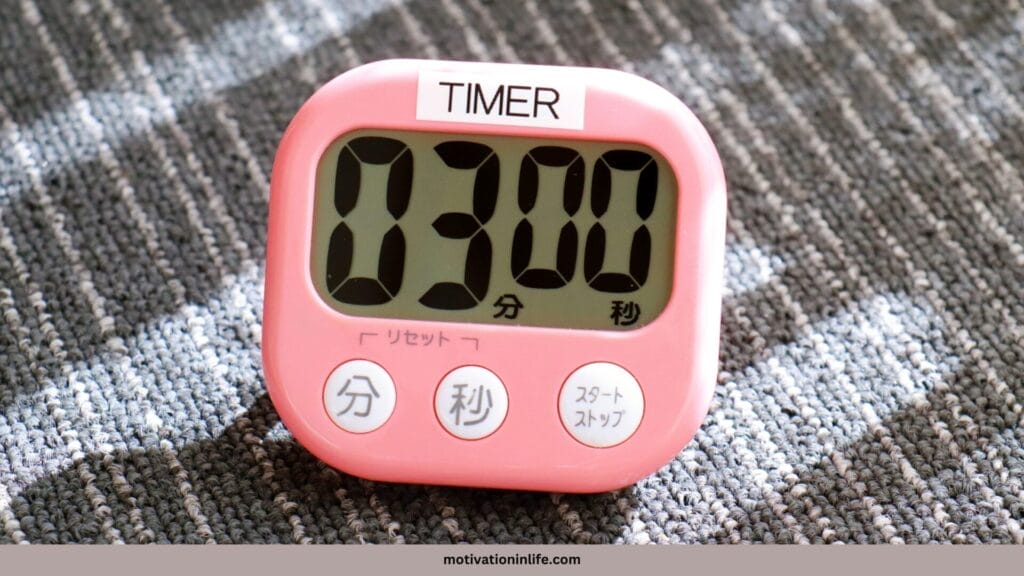
Use a Pomodoro Timer for Short Focus Periods
A Pomodoro timer helps break up tasks into smaller, manageable segments. This can be particularly effective if you find it hard to concentrate for long periods.
Set a timer for 25 minutes, focus on one task, then take a 5-minute break. Repeat this four times, and then take a longer 15-minute break. It’s a practical way to stay on task without feeling drained.
The Pomodoro technique can be especially beneficial for individuals in their 40s and beyond by breaking tasks into focused, manageable segments.
Here are three ways to incorporate this method effectively:
Manage Work Tasks with Intense Focus
Use the 25-minute intervals to concentrate on one specific work task, such as writing a report, reviewing documents, or tackling emails.
For those balancing a heavy workload, this helps in setting clear boundaries for each task and improving efficiency. Completing work tasks in focused chunks minimizes the chance of feeling mentally fatigued by the end of the day.
Break Up Home Responsibilities
Apply Pomodoro to manage home-related chores efficiently. Set a 25-minute timer to focus solely on one chore, like tidying up, organizing paperwork, or meal prepping.
After each focused block, take a 5-minute break to rest and stretch. This keeps household tasks from feeling overwhelming, and the regular breaks provide mental and physical recovery time.
Pace Personal Growth and Hobbies
For personal pursuits—like learning a new skill, reading, or working on a hobby—the Pomodoro method encourages consistent progress.
Spend 25 minutes on a hobby, like practicing an instrument or engaging in an online course, and take short breaks to avoid burnout. This approach is especially helpful in maintaining long-term interests and progress without overwhelming your daily schedule.
Using the Pomodoro technique in this way can help build a balanced routine that keeps work, home, and personal time on track.

Keep a Positive Mindset To Be Calm And Productive
How we approach time management makes all the difference. If you start with a positive mindset, you’re more likely to follow through.
Try using affirmations or gentle reminders, such as telling yourself, I can handle what’s on my plate today. A positive attitude can set a better tone for a productive day.
A positive mindset can significantly impact time management, especially for someone in midlife who is balancing career, family, and personal needs.
Here’s how a person in this phase of life can incorporate this approach effectively:
Begin the Day with Grounding Affirmations
Start each morning with a few affirmations that speak directly to your unique challenges and goals.
For instance, phrases like “I am in control of my schedule today,” or “I can accomplish what’s important and still make time for myself,” help frame the day with confidence.
By reinforcing a positive mindset first thing, you set a supportive tone for how you approach each task.
Use Mindful Check-ins Throughout the Day
Incorporate small check-ins, especially during high-stress moments, to recenter. A few moments of deep breathing combined with reminders like “I am managing my day at a pace that works for me,” or “I am doing my best,” can ease stress and help you refocus.
These pauses are especially helpful in busy midlife routines, where you’re likely juggling multiple priorities.
Reflect Positively at Day’s End
Take a few minutes each evening to appreciate what went well that day. Acknowledge completed tasks and appreciate your own efforts.
A positive end-of-day reflection supports long-term motivation, reinforcing the idea that each day’s progress matters.
This simple ritual can improve your mindset about time management overall, reducing stress and setting you up for the next day on a confident note.
By building these small, mindful practices into your routine, you’re more likely to maintain a balanced perspective and stay on track, even when juggling a full plate

Avoid Multi-Tasking For Effective Time Management
While multitasking can feel efficient, it usually divides attention and leads to incomplete work. Instead, focus on finishing one task before starting another.
This can reduce stress and give you a clearer sense of accomplishment as you check each item off your list. Using a Pomodoro timer or time blocks can help reduce the temptation to multi-task.
Here are 3 reasons why you should avoid multitasking for better management of your time
Improves Quality of Work
Focusing on one task at a time allows for deeper concentration, which typically improves the quality of work.
When you direct your full attention to a single task, there’s less chance of errors or missing important details, ultimately saving time spent on corrections.
Enhances Efficiency
Single-tasking allows for a smoother, more organized workflow, where each task gets completed in one go rather than being interrupted and revisited.
This reduces the mental strain of switching back and forth, helping you finish tasks faster and with less effort.
Boosts Sense of Completion
By completing tasks one by one, you gain a clear sense of progress and accomplishment.
This simple but effective approach helps you stay motivated throughout the day, providing a structured way to track progress and reducing the pressure to juggle everything at once.

Understand When You’re Likely to Procrastinate
Procrastination happens to everyone, but certain times or tasks might make you more inclined to put things off.
By paying attention to what those triggers are, you can plan ahead.
Perhaps some tasks feel overwhelming or dull, which leads to delays. Once you identify these patterns, you can approach them with a strategy to stay on track.
If you are prone to procrastination and are not aware of the reasons for the same, please read our blog post Understanding The 10 Reasons For Procrastination (For The 40+).
Limit Distractions When You Need to Focus
Recognize the common distractions that pull you away from tasks. Whether it’s your phone, unexpected visitors, or a bustling household, identify ways to reduce these interruptions.
Setting your phone to silent or closing unnecessary tabs on your computer can help keep your focus where it needs to be.
Here are some practical ways you can limit your distractions to complete the task at hand
Silence or Set Boundaries with Technology
Phones and notifications are among the biggest distractions. Try setting your phone to silent, or use a “Do Not Disturb” mode during focused work periods.
You can also disable non-essential notifications and close any unrelated browser tabs on your computer.
Create a Designated Workspace
If possible, set up a specific area at home or at work dedicated to focused tasks. A designated workspace not only signals to others that you’re busy, but it also helps you mentally transition into a focused mindset, making it easier to stay on task.
Communicate Boundaries with Others
Let family members or colleagues know when you need uninterrupted time. A simple note on your door or a polite message to colleagues can minimize unexpected interruptions.
Over time, this creates a mutual understanding and reduces the frequency of unplanned distractions.

Use a Calendar to Keep Track of Goals
A calendar doesn’t have to be filled hour by hour to be helpful. You can use it to keep track of major tasks and personal goals each month, breaking them down into smaller steps on a weekly or daily basis.
It provides a simple visual that can guide your day and ensure you stay aligned with what matters.
You can maintain a physical calendar in a planner or use digital calendars like Google Calendar or notion.
If the idea of using notion is overwhelming you can take this course on Notion by Arun Ramachandran to streamline your workflow. I found it very helpful.
Set Clear Boundaries Between Work and Personal Time
If you work from home or have flexible work hours, establishing boundaries between work and personal time is essential.
Set a designated time to start and finish your work, even if it’s at home. When the workday ends, step away from work tasks.
This helps keep a clear balance between professional obligations and personal relaxation.
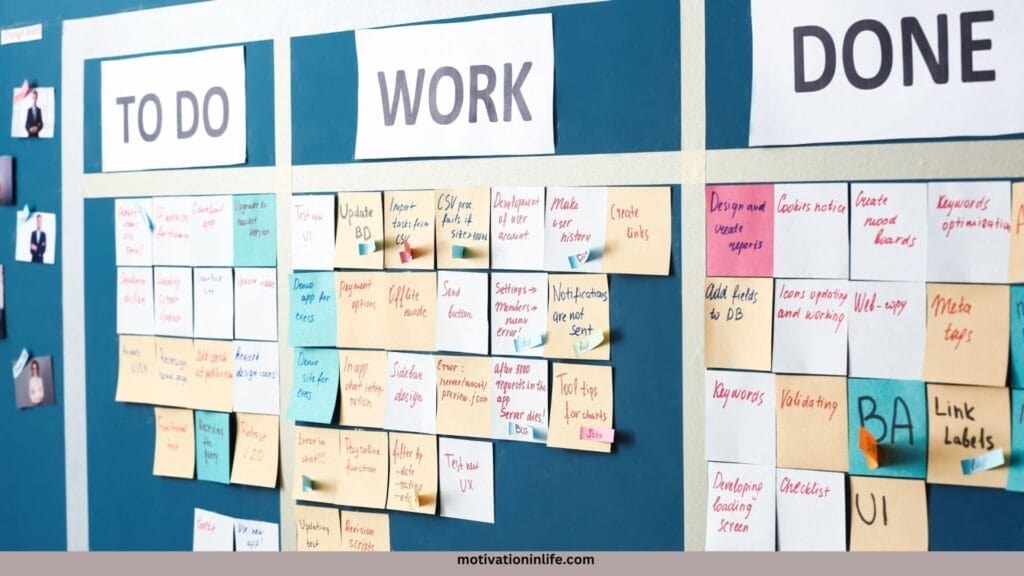
Batch Similar Tasks for Efficiency
Instead of switching back and forth between different types of tasks, group similar activities together.
For example, if you have several calls to make, try to complete them in one go.
Similarly, with paperwork or emails, handling them in batches can create a smoother workflow and keep your focus steady.
Identify and Minimize Time-Wasting Activities
Be aware of common time-wasters. Whether it’s excessive social media scrolling, frequent interruptions, or spending too much time on emails, these habits can add up.
While breaks are essential, using time wisely helps you get through important tasks with less stress. Setting gentle reminders for yourself can be a good way to keep these activities from disrupting your day.
If you do not feel motivated enough, please read our blog post 15 Proven Tactics Of How To Get Motivation Back In Life (For The 40+).
How To Manage Your Time In Life After 40- Key Takeaways
In midlife, mastering time management can be a game-changer, helping you balance career, family, and personal time with less stress.
By prioritizing tasks, focusing on one thing at a time, and reducing distractions, you’re building a routine that promotes both productivity and well-being.
These strategies bring clarity and calm to your days and allow for meaningful growth and quality time. With the right approach, you can make each day count and create a schedule that truly reflects your values and goals.
Recommended Books That You Must Read To Effectively Manage Your Time
Make Time: How to Focus on What Matters Every Day By Jake Knapp and John Zeratsky (Amazon.com | Amazon.in)
168 Hours: You Have More Time Than You Think By Laura Vanderkam (Amazon.com | Amazon.in)
IF YOU ENJOYED READING THIS POST, PLEASE PIN ONE OF THESE IMAGES BELOW!
I will be grateful for your kind gesture. Thank you!
